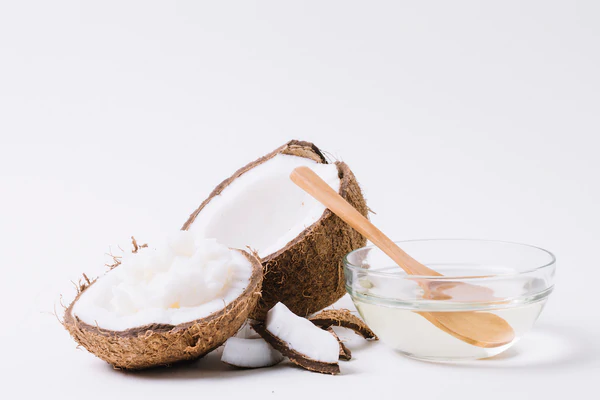Carrier Oils
Everything You Need to Know About Coconut Oil
Coconut oil is known for its rich water content that is, in fact, one of the highest among all fruits. This is responsible for making coconut so nourishing and moisturizing.
Coconut oil has been an integral component of beauty formulations around the world. This is especially true of the coastal and tropical regions.
Did you know that the word “coconut” finds its origins in the Spanish and Portuguese words from the 16th century? The word stands for “skull” since the fruit resembles the human head owing to the indents.
Coconut oil is widely used in cosmetics and is frequently added to soap formulations. The key to the power of coconut oil is its powerful hydration capability. The oil has also been used, since times immemorial, to treat infections, heal wounds, and protect the skin. It will also remove blemishes and keep the skin healthy.
Whether you wanted a natural replacement for chemical-laden cosmetic products or a way to rid your skin’s dryness in a natural manner, coconut oil is a great option to consider.

Historic Aspects of Coconut Oil
Coconut is most known for its rich water content. Coconuts are commonly harvested for their water content. However, since ancient times, various parts of coconut and the tree have been used for a variety of purposes.
The tree is a part of the Palm family actually. Experts believe that it is the only plant species in the Cocos genus. Coconut oil, for hundreds of years, has been an important part of many beauty products across cultures. One of the key advantages of coconut oil is that it boosts hair growth.
Coconut oil will keep the skin moisturized and conditioned well and this will contribute to luster and hair strength. Even today, coconut oil finds numerous cosmetic applications: it is a key component of moisturizers and is often added to soaps.
The coconut, contrary to what the name suggests, is not a nut in the real sense of the word. The fruit is fleshy and has thin skin. The inner stone contains the seed. For centuries now, coconuts are processed in a way that the kernel is used to yield oil while the shell yields charcoal. The outer husk that is fibrous in texture is often used to make matting and ropes.
Coconut oil has been used for centuries and has been a part and parcel of the lives of people across the world. This is particularly true of the cultures in Africa, South America, the Indian subcontinent, Central America, Polynesia, and Asia.
The medicinal benefits of coconut oil for treating diseases of the body, mind, and spirit have been documented in ancient Sanskrit verses dating back at least 3,500 years.
Coconuts find mentions in numerous historical as well as fictional accounts. Coconuts are believed to have been used to make fiber in China in the 9th century. Even the legendary story Sinbad the Sailor in Arabian NIghts mentions the fruit.
It is said coconuts were also mentioned by Costas, an Egyptian traveler in the 5th century who saw an “Indian nut” in the course of his travels. Coconut oil was commonly used in hair care products in South Asia. It was used for keeping the hair dark, thick, and lustrous.
What’s more, coconut oil has also been used as a powerful remedy to treat burns, cuts, bruises, and wounds and helps facilitate rapid healing. The oil can also relieve several joint pain types and muscular discomfort. has also been used in making candles in India and Zanzibar.
Coconut oil was extensively used by Ayurvedic practitioners and the healers in South and Central America. It was used to heal cuts and wounds. Coconut oil was commonly used by mothers who used to massage their kids with the oil to help strengthen their bones. The oil was also known to protect the skin against infections and remove blemishes and marks.
It is believed that the name “coconut” owes its existence to the Portuguese. They have been known by various names including “Nux Indica” as Marco Polo called them in the 13th century. They were also known as “Nargils” in the 17th century as Sir Drake called them.
The name “coconut” finally came in the 16th century from the word “coco” in the Spanish and Portuguese languages. The word means “head” or, in other words, “skull”. This was owing to the shape of the coconut resembling the human head with its eyes and nose.
Nations where coconut was natively found still use coconuts to produce utensils, baskets, and musical instruments. Natives discovered that the flesh of the fruit could be used for a number of purposes apart from consumption as food. They used to boil the milk of the coconut to obtain the oil.
Coconut was also used as a sunscreen agent. It also functioned as a moisturizer and a conditioner that could restore the luster of damaged hair and skin. It was used as a remedy for treating head lice too.
The Components of Coconut Oil
Let us now dive deeper into the components that give its amazing health benefits. We will discuss each of these components in detail and see what makes them really special.
Each of these components, that includes fatty acids and vitamins, has a vital role to play in making coconut oil a marvel of nature. In this section, we shall see the individual components of the oil and their respective unique properties that make them stand apart.

